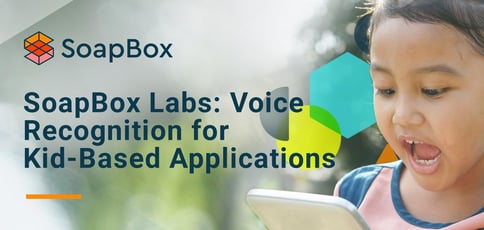
TL; DR: SoapBox Labs builds speech recognition technology tailored to kid-based educational and entertainment applications. The company helps other businesses and developers finalize their application models with voice-enabled interfaces. Its innovations have helped diversify mainstream voice interfaces and pioneer cutting-edge privacy-by-design technology for children.
Many stories of entrepreneurship and innovation begin by discovering a problem that needs solving. And that was definitely the case for Dr. Patricia Scanlon when she stumbled upon the idea for SoapBox Labs.
Patricia discovered an issue with her daughter’s literacy app, which followed a gamified approach that moved learners through levels after they answered a few multiple-choice questions.
But there was no proof that her daughter retained the information or skills the app had promised.
So, Patricia found a performance solution in speech recognition. Players could pronounce the words, be graded on valid measures, and move through levels as they start to improve their pronunciations.

With a background in engineering and research, Patricia brainstormed ways to develop a voice engine for children. Still, she realized not enough data on children’s voices existed to build an efficient speech recognition system. So she partnered with Trinity College in Dublin to get the project off the ground.
“We spun Patricia into the university as an entrepreneur and incubated the idea for 18 months with funding from the state.After those 18 months, she was able to spin out and create SoapBox Labs as an entity,” said Dr. Martyn Farrows, who met Patricia at Trinity and is now the CEO of SoapBox Labs.
Now, SoapBox Labs provides developers with the interface technology to create educational and entertainment apps for children. The company built its speech recognition solution to empower children of all ages, accents, and backgrounds. And it continues to develop and research innovations to improve voice-enabled experiences for kids.
“Our mission is to create joyful and magical experiences for kids. But we are the enabling technology that sits behind the interface of these applications,” said Dr. Farrows.
Bringing Educational Applications to Life with Voice Recognition
Dr. Scanlon created SoapBox Labs to redefine how children interact with educational applications using their voices. Today, the company works with two main markets to achieve this mission – education and entertainment which includes games, media and toys.
“Our customers are anybody who wants to use voice to bring an experience for a child to life. And to do that using a system that has been built for kids from the ground up. So we work in two main markets; one is education,” said Dr. Farrows.
Developers and companies building speech-enabled applications can look to SoapBox Labs to source their voice engine technologies. The SoapBox team partners with large education publishers in the US and globally. These strategic partnerships span multiple products and years as the use of voice scales across product portfolios in areas such as practice, assessment and intervention.
There are an infinite number of use cases for voice technology in kid-based applications. The company supports literacy apps, screeners for dyslexia, math games, among other subjects.
“Adults tend to use it for practical things. The tendency is to move toward the utility of voice. With kids, it’s a more creative space because the use cases for voice are diverse,” said Dr. Farrows.
A unique detail about SoapBox technology is that it accommodates diversity in children’s voices and ages. It can process and recognize different dialects and accents with high accuracy. The company also prioritizes privacy and proactively builds systems that protect children from being profile for commercial purposes or individually identified.
“Privacy is in our DNA. We are one of the pioneers of the whole privacy-by-design approach. So everybody in the business is aware of the need to protect the fundamental digital privacy rights of kids,” said Dr. Farrows.
How the SoapBox Labs Changed the Interface Market
When SoapBox Labs launched in 2013, the voice interface market was only emerging. Voice technology tools such as Alexa and Siri were mere shadows of their present forms. And voice simply couldn’t compete as a mainstream interface because of its poor user experience.
SoapBox Labs helped advance speech recognition technology with its adaptable voice engine while opening the pathways for market growth, particularly in the area of 2-12 year old kids.
“We probably underestimated the amount of work or effort that we would need to put into educating the market about how to deploy voice technology,” said Dr. Farrows.

The technology was fairly new, and few UX designers knew how to build voice technology at the time, especially for a young customer base. The SoapBox Labs team documented its development to educate its customers and help them understand the technology.
“Quite early on, we realized that it was a good way to build partnerships since we had people coming to us asking these questions. Well, why don’t we help you understand how to solve this problem,” said Dr. Farrows.
The company built a developer portal and shared its API details with customers. SoapBox Labs simplified the adoption process and created a self-service model by adding this information. So, clients could easily plug the solution into their application.
What’s Next: Building Offline and Edge AI Solutions
Educational-based speech recognition technology is needed more than ever as the pandemic affects education on all levels. Schools have seen drops in reading proficiency and other subjects following safety measures that included school shutdowns. SoapBox Labs solutions will also help advance remote learning and improve academic performance. And the company isn’t stopping there.
Dr. Farrows said the team is working on new delivery mechanisms. SoapBox Labs plans to add offline solutions and edge AI features to its lineup in the near future.
“We are an online API-based service at the moment. But increasingly, we’re building offline solutions. So offline, being on a device, as in a mobile device,” said Dr. Farrows.
The team is developing an offline solution that could be used for mobile devices, as an SDK, or on a toolkit for developers to embed into chips. This offline solution can combine with applications, including VR and AR. SoapBox Labs will also add voice-enabled technology to edge AI chips on toys to power command and control experiences, for example.
The demand for voice technology tools doesn’t look to be slowing down soon any time soon, as the global market will grow by 16.8% by 2026. Fortunately, SoapBox Labs innovations are here to stay.
“We’re always looking for new and creative ways to use voice for kids. Within the next 12 months, many more people will have come to us with new use cases.. So we’re never going to exhaust that part of the market,” said Dr. Farrows.
HostingAdvice.com is a free online resource that offers valuable content and comparison services to users. To keep this resource 100% free, we receive compensation from many of the offers listed on the site. Along with key review factors, this compensation may impact how and where products appear across the site (including, for example, the order in which they appear). HostingAdvice.com does not include the entire universe of available offers. Editorial opinions expressed on the site are strictly our own and are not provided, endorsed, or approved by advertisers.
Our site is committed to publishing independent, accurate content guided by strict editorial guidelines. Before articles and reviews are published on our site, they undergo a thorough review process performed by a team of independent editors and subject-matter experts to ensure the content’s accuracy, timeliness, and impartiality. Our editorial team is separate and independent of our site’s advertisers, and the opinions they express on our site are their own. To read more about our team members and their editorial backgrounds, please visit our site’s About page.



